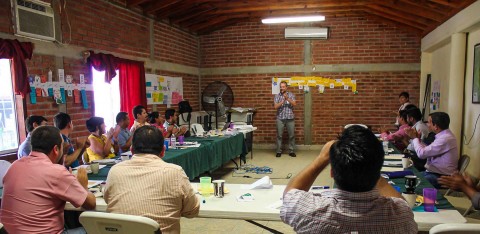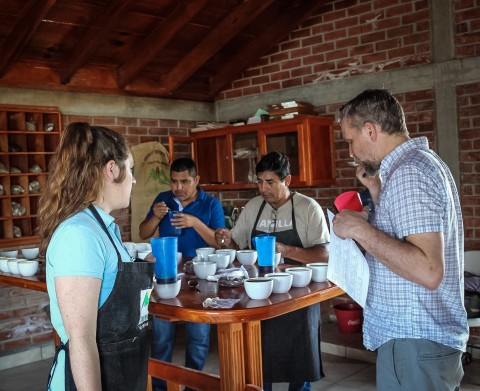By Todd Caspersen, Director of Purchasing and Production
Every year Equal Exchange evaluates how we did against an established set of Measures of Success. Profitability is but one of many critical aspects we measure. Of greater interest is how we have done by our various stakeholders including but not limited to farmers, consumers and worker owners.
This year we asked our director of purchasing and production, Todd Caspersen, to conduct a critical analysis of how we think our coffee farmer cooperatives are faring. His assessment is sobering. We have decided to share it in this space, unsparing and unfiltered, believing that this level of analysis will make all of us more informed and enable us to critically assess where in the years to come we can collectively make the most progress in building supply chains that truly work for small scale coffee farmers, Equal Exchange and our customers. As always, we welcome your feedback.
Equal Exchange and our Coffee Farmer Partners - 2018
The global context for coffee producers and their organizations continues to be:
- Volatile Commodity markets
- Volatile currency value
- Climate change
- Leaf Rust
- Aging farming population
- Lack of access to affordable credit
- Underinvestment by the state
- Poor to non-existent extension services
- Consolidation in the food system
- Stagnant and fractured Fair Trade market
Given the context, I will discuss two key strategy components that our coffee team is implementing to navigate these waters.
Pricing Strategy (all prices FOB)
The current market price of $1.20 to $1.30/lb. is not a sustainable price for the majority of the world’s coffee farmers. Organizations and farmers that are linked with these price levels will continue to suffer grinding poverty. Organizations that are well articulated with the FT market are receiving the FT minimum price of $1.60/lb. conventional or $1.90/lb. organic, these price levels are semi-sustainable for some organizations but not all. Generally, the margins do not leave enough for investment at the farm or organization level. The feedback we have received from our partners is that $2.20 to $2.50 per pound allows for solid farm gate prices as well as some margin for the organizations which can be used to invest. Our current average price is $2.38/lb.
Our volume is really important to our farmer partners as it helps to raise the average price they receive. Our partners have a hard time finding buyers that will match or beat our prices at any significant volume. There are cases where they may have another buyer that is matching or beating our prices. A few have significant relationships with other independent U.S. importers or U.S.-based specialty buyers. In these cases the coops are in better shape than many of their peers who sell significant percentage of their volume at market price or FT minimum. To ensure coffee supply in the future it’s important that our producer partners have the capacity to invest at the farm and organizational levels and some or all of that must come from the price.
Fair Trade is not growing in the US and significant players have reduced or eliminated their engagement with FT. Keurig/Green Mountain has significantly reduced purchases and changed the terms (180 days to brokers); Dunkin Donuts has dropped the FT seal altogether. Direct Trade offers some good pricing but the volumes remain relatively small and much of it appears to be with larger sized farms. Our producer partners are facing an increasingly difficult market environment while the large global forces such as climate change intensify.
The Coffee Leaf Rust crisis is not over. Sadly, just as the renovation work that started in 2010-13 is bearing fruit the commodity price has tanked and there is a significant surplus for coffee in the world making for a difficult market environment. In short, creatures in our ecosystem are in peril and we need to identify, test and implement adaptation strategies.

Non Commercial Activities (heretofore NCA’s)
As referenced above the price we pay for coffee is diluted, in most cases, by the sale of coffee to other actors who are paying FT minimum price or market prices resulting in a lower farm gate price and smaller or no margins for the organizations. It can also be argued that price alone is not enough to create or spark positive community development and therefore other forms of cooperation are necessary to make tangible economic, environmental and social progress. Feedback from our producer partners has been they place high value on our relationship because of the price we pay but also they value the NCA’s that we support. We value NCA’s because they strengthen our value chain and inch us forward on development paths.
The strategic plan 2017-2020 for the coffee group is to continue and expand our engagement with NCA’s. A small group of product managers has recently been looking at our NCA’s and recently developed a draft dashboard to keep track of all our current projects and to document projects that we have completed. The dashboard is not complete but information gathered to date shows 19 significant projects since 2004 with an investment over $7,000,000 USD. The funding has been a mix of USAID, EE expenses, profit from product sales, other NGO funding and donations.
The impact, learning and network development related to these projects is substantial and exciting and yet the scale and scope of the challenges faced by our ecosystem is humbling. We estimate 20,000 + producers in our coffee value chain, based on our current understanding minimum agronomic intervention cost $250/producer/year. You do the math.
NCA work poses all kinds of interesting questions.
- How does it relate to our commercial identity and priorities?
- Where should the funding come from?
- Can a product manager also manage development projects?
- What is the best vehicle for this work?
- Who are our best partners and allies in this work?
- What do failure and success look like?
- How to measure impact?

We are hard at work on these questions and other activities related to these two strategy components and believe that a shifting combination of the two and others will be a strength moving forward.
